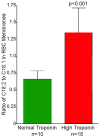Nature and nurture in atherosclerosis: The roles of acylcarnitine and cell membrane-fatty acid intermediates
- PMID: 26133667
- PMCID: PMC4696919
- DOI: 10.1016/j.vph.2015.06.012
Nature and nurture in atherosclerosis: The roles of acylcarnitine and cell membrane-fatty acid intermediates
Abstract
Macrophages recycle components of dead cells, including cell membranes. When quantities of lipids from cell membranes of dead cells exceed processing capacity, phospholipid and cholesterol debris accumulate as atheromas. Plasma lipid profiles, particularly HDL and LDL cholesterol, are important tools to monitor atherosclerosis risk. Membrane lipids are exported, as triglycerides or phospholipids, or as cholesterol or cholesterol esters, via lipoproteins for disposal, for re-use in cell membranes, or for fat storage. Alternative assays evaluate other aspects of lipid pathology. A key process underlying atherosclerosis is backup of macrophage fatty acid catabolism. This can be quantified by accumulation of acylcarnitine intermediates in extracellular fluid, a direct assay of adequacy of β-oxidation to deal with membrane fatty acid recycling. Further, membranes of somatic cells, such as red blood cells (RBC), incorporate fatty acids that reflect dietary intake. Changes in RBC lipid composition occur within days of ingesting modified fats. Since diets with high saturated fat content or artificial trans-fatty acids promote atherosclerosis, RBC lipid content shifts occur with atherosclerosis, and can show cellular adaptation to pathologically stiff membranes by increased long-chain doubly unsaturated fatty acid production. Additional metabolic changes with atherosclerosis of potential utility include inflammatory cytokine production, modified macrophage signaling pathways, and altered lipid-handling enzymes. Even after atherosclerotic lesions appear, approaches to minimize macrophage overload by reducing rate of fat metabolism are promising. These include preventive measures, and drugs including statins and the newer PCSK9 inhibitors. New cell-based biochemical and cytokine assays provide data to prevent or monitor atherosclerosis progression.
Keywords: Atherogenesis; Carnitine; Cholesterol synthesis; Coenzyme A; Fcγ; HDL; LDL; PCSK9; Statin.
Copyright © 2015 Elsevier Inc. All rights reserved.
Figures




Similar articles
-
Replacement of Dietary Saturated Fat by PUFA-Rich Pumpkin Seed Oil Attenuates Non-Alcoholic Fatty Liver Disease and Atherosclerosis Development, with Additional Health Effects of Virgin over Refined Oil.PLoS One. 2015 Sep 25;10(9):e0139196. doi: 10.1371/journal.pone.0139196. eCollection 2015. PLoS One. 2015. PMID: 26405765 Free PMC article.
-
The role of dietary oxidized cholesterol and oxidized fatty acids in the development of atherosclerosis.Mol Nutr Food Res. 2005 Nov;49(11):1075-82. doi: 10.1002/mnfr.200500063. Mol Nutr Food Res. 2005. PMID: 16270280 Review.
-
Krill oil reduces plasma triacylglycerol level and improves related lipoprotein particle concentration, fatty acid composition and redox status in healthy young adults - a pilot study.Lipids Health Dis. 2015 Dec 15;14:163. doi: 10.1186/s12944-015-0162-7. Lipids Health Dis. 2015. PMID: 26666303 Free PMC article. Clinical Trial.
-
Lipoprotein ability to exchange and remove lipids from model membranes as a function of fatty acid saturation and presence of cholesterol.Biochim Biophys Acta Mol Cell Biol Lipids. 2020 Oct;1865(10):158769. doi: 10.1016/j.bbalip.2020.158769. Epub 2020 Jul 23. Biochim Biophys Acta Mol Cell Biol Lipids. 2020. PMID: 32712249
-
The relation of lipid peroxidation processes with atherogenesis: a new theory on atherogenesis.Mol Nutr Food Res. 2005 Nov;49(11):999-1013. doi: 10.1002/mnfr.200500055. Mol Nutr Food Res. 2005. PMID: 16270286 Review.
Cited by
-
Diet-Induced Severe Hyperhomocysteinemia Promotes Atherosclerosis Progression and Dysregulates the Plasma Metabolome in Apolipoprotein-E-Deficient Mice.Nutrients. 2024 Jan 23;16(3):330. doi: 10.3390/nu16030330. Nutrients. 2024. PMID: 38337615 Free PMC article.
-
Metabolic systems approaches update molecular insights of clinical phenotypes and cardiovascular risk in patients with homozygous familial hypercholesterolemia.BMC Med. 2023 Jul 27;21(1):275. doi: 10.1186/s12916-023-02967-8. BMC Med. 2023. PMID: 37501168 Free PMC article.
-
Macrophage Polarization in Atherosclerosis.Genes (Basel). 2022 Apr 25;13(5):756. doi: 10.3390/genes13050756. Genes (Basel). 2022. PMID: 35627141 Free PMC article. Review.
-
Correlation of Serum Acylcarnitines with Clinical Presentation and Severity of Coronary Artery Disease.Biomolecules. 2022 Feb 23;12(3):354. doi: 10.3390/biom12030354. Biomolecules. 2022. PMID: 35327546 Free PMC article.
-
Metabolic Impairment in Coronary Artery Disease: Elevated Serum Acylcarnitines Under the Spotlights.Front Cardiovasc Med. 2021 Dec 16;8:792350. doi: 10.3389/fcvm.2021.792350. eCollection 2021. Front Cardiovasc Med. 2021. PMID: 34977199 Free PMC article.
References
Publication types
MeSH terms
Substances
Grants and funding
LinkOut - more resources
Full Text Sources
Other Literature Sources
Medical
Miscellaneous

